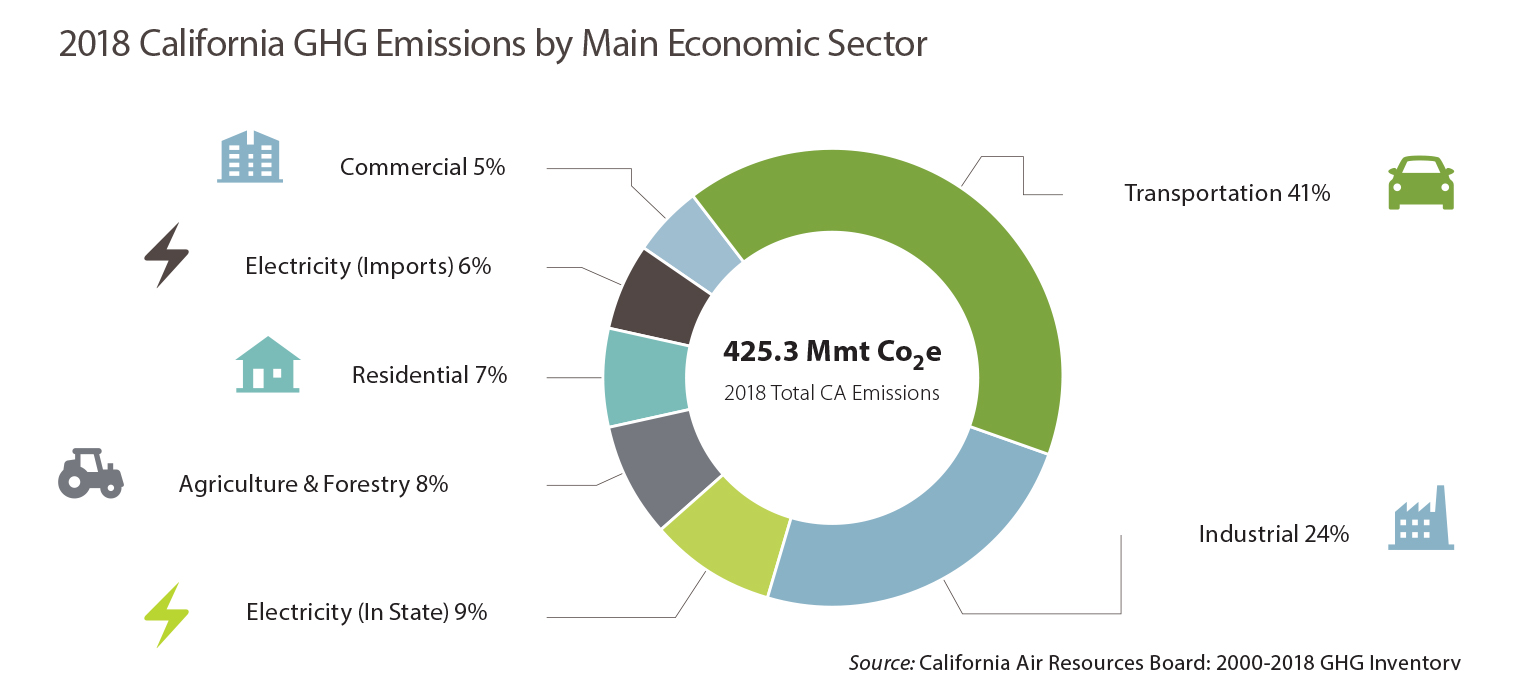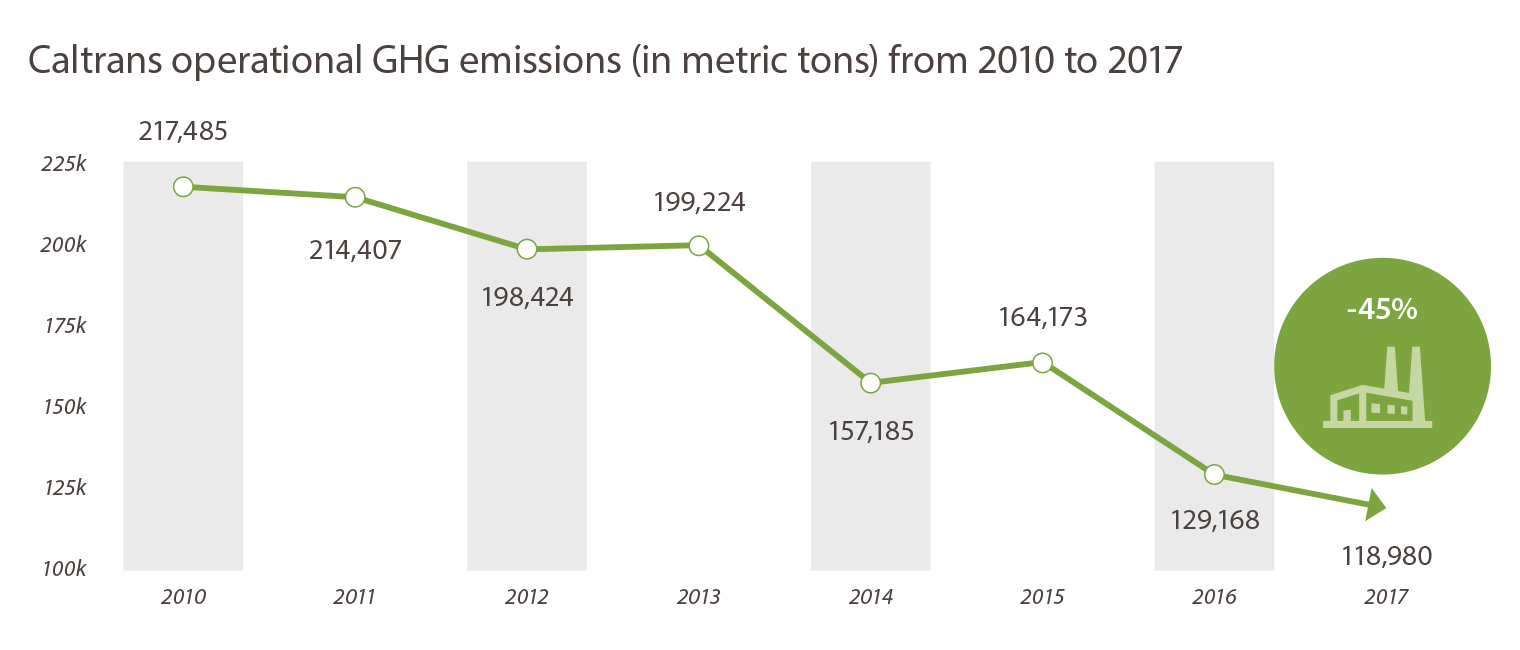Driving Down Greenhouse Gas Levels

Strategy to Reduce Vehicle Miles on Roadways Key to Meeting State Goals
Caltrans has an important role to play in fostering solutions that reduce transportation greenhouse gas (GHG) emissions, which are contributing to climate change impacts statewide. Caltrans is already reducing GHG emissions through operational efficiencies and sustainable management of the State Highway System.
In its GHG Emissions and Mitigation Report, Caltrans describes the actions taken to this point to reduce GHG emissions, quantifies the amount of GHG produced by its operations, and identifies future opportunities to further reduce emissions. The report also reviews the emission sources that Caltrans can control or influence.
Emissions from the transportation sector are the largest contributor to heat-trapping gases that alter climate patterns in California and nationally, according to the U.S. Environmental Protection Agency, California Air Resources Board and the GHG Emissions and Mitigation Report. The latest research forecasts that impacts from climate change in California will increase in severity and scale through the end of the century. Given current emission trends, climate predictions include increased temperatures, more intense wildfire seasons, more frequent flooding, extended drought cycles, and rising sea levels.
According to the Air Resources Board’s most recent report, California sources emitted 425 million metric tons of GHGs in 2018. An estimated 89 million metric tons of those gases were generated by traffic on the Caltrans-managed State Highway System, the equivalent of 21 percent of the state’s total GHG emissions. Factoring in an estimated 32 million metric tons from extracting and producing vehicle fuels, emissions from vehicle tailpipe sources in 2018 accounted for 41 percent of the state’s total GHG emissions. The second largest contributor to the state’s total GHG emissions is the industrial sector (24 percent), followed by electricity generation (15 percent).

Vehicle miles tied to GHG emission increases
Although state climate policy anticipates that improving vehicle technology and fuel efficiency standards will help curb GHG emissions, the report emphasizes that major progress for cleaner air must come from reducing vehicle miles traveled (VMT) on state roadways.
The report asserts that Caltrans and other government and transportation entities can do a great deal to counter an increase in VMT and corresponding rise in GHG emissions. The State Highway System saw 195 billion vehicle miles of travel in 2016, which represented 57 percent of all VMT in the state that year. After declines in the early 2000s, statewide VMT and VMT per capita began growing again in 2013 due to increased passenger vehicle travel — a development that made compliance with state-mandated reductions in GHG more difficult, according to a recent Air Resources Board assessment.
Because Caltrans plans, builds, and operates most of the state’s highway system, it has unique opportunities to influence on-road vehicle travel in the state. The GHG Emissions and Mitigation Report offers these strategies as most effective in reducing emissions:
- Revise planning, programming, and project development procedures to minimize highway capacity expansion projects that unintentionally encourage single-occupancy vehicle travel, which increases statewide VMT and GHG emissions.
- Promote and expand roadway pricing.
- Support transportation system improvements that provide multimodal and active transportation alternatives to shift travelers away from single-occupancy vehicle trips that account for the bulk of GHG emissions.
In addition to influencing users of the transportation system, the report identifies opportunities for Caltrans to reduce emissions through internal operations and contractors’ materials and operations. The maintenance and operation of the State Highway System requires extensive resources such as paving materials, electricity for lighting, water for landscaping, and fuel for a large fleet of vehicles.
The report says using more energy-efficient and less carbon-intensive materials for roadway construction and maintenance appear to offer the highest potential for reducing operational GHG emissions.
Internal measures to control carbon are not enough
Highway construction and maintenance projects accounted for 2.5 million metric tons of GHG emissions in 2017, or 0.6 percent of statewide emissions. Caltrans internal operations, such as fuel for the vehicle fleet, and facility and highway lighting, produced 120,000 metric tons of greenhouse gases in 2017, or 0.03 percent of the statewide total. Efficiencies and new technology adoption in those areas under direct Caltrans control have produced a 45 percent decline in GHG levels since 2010, the report noted.

While Caltrans has reduced its own carbon footprint in the last decade, adopting strategies to shift travel patterns on the state travel network presents the best approach to significantly lower VMT and GHG levels, the report asserts.
By promoting multimodal transportation options, ridesharing, and active transportation, Caltrans can manage demand for travel in single-occupancy vehicles. Within the transportation sector, about 70 percent of GHG emissions come from on-road passenger vehicles (i.e., light-duty vehicles). Another 21 percent comes from on-road heavy-duty vehicles (i.e., freight trucks and buses). The remaining sources of transportations emissions account for a relatively small fraction of the state’s total GHG emissions.
The report emphasized that it is essential to address the emissions produced by vehicles on the State Highway System if the state is to meet the GHG and VMT reductions goal established under legislation and executive orders.
Opportunities to reduce highway-generated emissions include:
Minimizing induced vehicle travel
Although it seems counterintuitive, projects that expand highway capacity with the intent to relieve congestion in urban areas often exacerbate the problem by encouraging more vehicle trips. This phenomenon is known as induced travel. There is little evidence that even conventional traffic-reduction strategies such as high-occupancy vehicle lanes help counter overall VMT and GHG growth. Although some capacity-enhancing projects may yield benefits in reduced congestion or GHG, the report said careful planning and research is needed to quantify these impacts.
Implementing express lanes
A more directed approach to altering driver behavior has been the adoption of toll roads and express lanes. California now has 214 miles of express lanes, with more in the planning stage. Studies of areas that have adopted roadway pricing strategies have shown they can reduce traffic significantly, the report said, as travelers seek out less costly trip alternatives such as transit, ridesharing, bicycling and walking.
Equity concerns have been raised regarding roadway pricing, the report noted. To counter these equity issues, discounted pricing could be offered those who qualify, and some of the revenue raised through tolls could go toward improving transportation access in disadvantaged and low-income communities.
Adopting alternative travel modes and strategies
Caltrans has increasingly taken the lead on developing multimodal and active transportation plans that attempt to draw people out of their cars. Caltrans works with transportation partners on transit system improvements, land use planning, parking, and transportation demand strategies such as commute options, rideshare, carshare, and telework.
The Department uses a variety of internal planning tools and operational controls to reduce GHG and VMT. The Caltrans GHG Emissions and Mitigation Report presents a comprehensive overview of those efforts.
Caltrans also has published a series of Climate Change Vulnerability Assessments in each of the 12 regional districts that identify segments of the State Highway System vulnerable to projected climate change impacts, including precipitation, temperature, wildfire, sea level rise, storm surge, and cliff retreat.
The Caltrans 2020-24 Strategic Plan includes climate action performance measures and targets, several of which relate to GHG reduction.
Sources: Caltrans Greenhouse Gas Emissions and Mitigation Report; Caltrans Division of Transportation Planning; Caltrans Division of Environmental Analysis.

